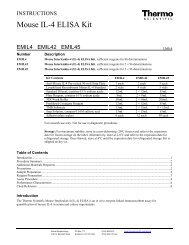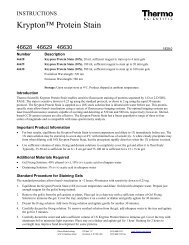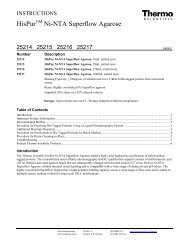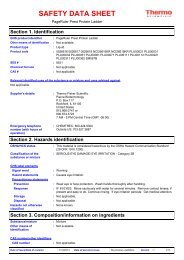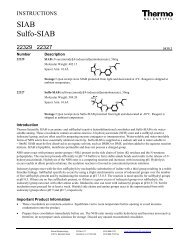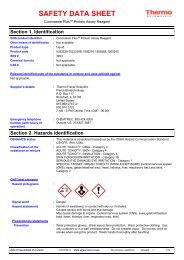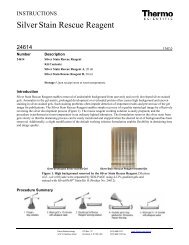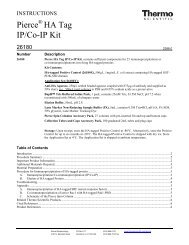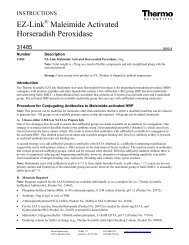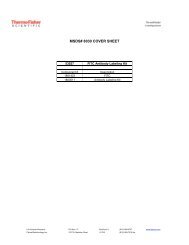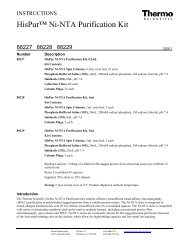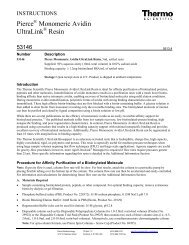Thermo Scientific Pierce Protein Assay Technical Handbook Version 2
Thermo Scientific Pierce Protein Assay Technical Handbook Version 2
Thermo Scientific Pierce Protein Assay Technical Handbook Version 2
You also want an ePaper? Increase the reach of your titles
YUMPU automatically turns print PDFs into web optimized ePapers that Google loves.
Modified Lowry <strong>Protein</strong> <strong>Assay</strong><br />
Modified Lowry <strong>Protein</strong> <strong>Assay</strong><br />
Although the mechanism of color formation for the Modified<br />
Lowry <strong>Protein</strong> <strong>Assay</strong> is similar to that of the BCA <strong>Protein</strong> <strong>Assay</strong>,<br />
there are several significant differences between the two.<br />
In 1951 Oliver H. Lowry introduced this colorimetric total protein<br />
assay method. It offered a significant improvement over previous<br />
protein assays and his paper became one of the most cited references<br />
in the life science literature. The Modified Lowry <strong>Protein</strong><br />
<strong>Assay</strong> uses a stable reagent that replaces two unstable reagents<br />
described by Dr. Lowry. The Modified Lowry assay is easy to<br />
perform because the incubations are done at room temperature<br />
and the assay is sensitive enough to allow the detection of total<br />
protein in the low microgram per milliliter range. Essentially, the<br />
Modified Lowry protein assay is an enhanced biuret assay involving<br />
copper chelation chemistry.<br />
Chemistry of the Modified Lowry <strong>Protein</strong> <strong>Assay</strong><br />
Although the mechanism of color formation for the Modified<br />
Lowry <strong>Protein</strong> <strong>Assay</strong> is similar to that of the BCA <strong>Protein</strong><br />
<strong>Assay</strong>, there are several significant differences between the<br />
two. The exact mechanism of color formation in the Modified<br />
Lowry <strong>Protein</strong> <strong>Assay</strong> remains poorly understood. It is known that<br />
the color-producing reaction with protein occurs in two distinct<br />
steps. As seen in Figure 1, protein is first reacted with alkaline<br />
cupric sulfate in the presence of tartrate during a 10-minute<br />
incubation at room temperature. During this incubation, a<br />
tetradentate copper complex forms from four peptide bonds and<br />
one atom of copper. The tetradentate copper complex is light<br />
blue in color (this is the “biuret reaction”). Following the incubation,<br />
Folin phenol reagent is added. It is believed that the color<br />
enhancement occurs when the tetradentate copper complex<br />
transfers electrons to the phosphomolybdic/phosphotungstic<br />
acid complex (the Folin phenol reagent).<br />
The reduced phosphomolybdic/phosphotungstic acid complex<br />
produced by this reaction is intensely blue in color. The Folin<br />
phenol reagent loses its reactivity almost immediately upon<br />
addition to the alkaline working reagent/sample solution. The blue<br />
color continues to intensify during a 30-minute room temperature<br />
incubation. It has been suggested by Lowry, et al. and by Legler,<br />
et al. that during the 30-minute incubation, a rearrangement of the<br />
initial unstable blue complex leads to the stable final blue colored<br />
complex that has higher absorbance.<br />
For small peptides, the amount of color increases with the size<br />
of the peptide. The presence of any of five amino acid residues<br />
(tyrosine, tryptophan, cysteine, histidine and asparagine) in the<br />
peptide or protein backbone further enhances the amount of color<br />
produced because they contribute additional reducing equivalents<br />
to further reduce the phosphomolybdic/phosphotungstic<br />
acid complex. With the exception of tyrosine and tryptophan, free<br />
amino acids will not produce a colored product with the Modified<br />
Lowry Reagent; however, most dipeptides can be detected. In the<br />
absence of any of the five amino acids listed above in the peptide<br />
backbone, proteins containing proline residues have a lower color<br />
response with the Modified Lowry Reagent due to the amino acid<br />
interfering with complex formation.<br />
R<br />
R<br />
CH<br />
C NH CH C NH<br />
O<br />
O<br />
Peptide<br />
Bonds<br />
+<br />
Cu 2+<br />
OH –<br />
Tetradentate<br />
Cu 1+<br />
Complex<br />
O<br />
O<br />
CH<br />
R<br />
C NH CH C NH<br />
<strong>Protein</strong><br />
Tetradentate<br />
Cu 1+<br />
Complex<br />
+<br />
Mo 6+ /W 6+<br />
OH -<br />
Folin Reagent<br />
(phosphomolybdic/phosphotungstic acid)<br />
BLUE<br />
A max = 750nm<br />
Figure 1. Reaction schematic for the Modified Lowry <strong>Protein</strong> <strong>Assay</strong>.<br />
To order, call 800-874-3723 or 815-968-0747. Outside the United States, contact your local branch office or distributor.<br />
27



